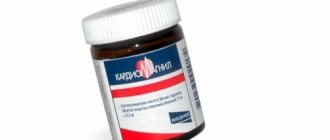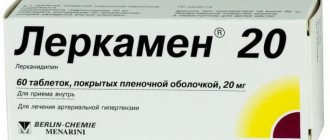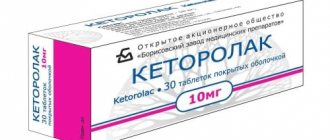Release form and composition
The following dosage forms of Methotrexate are available:
- Tablets: coated from dark pink to pink (in blister packs of 10 pcs., 5 packs in a cardboard pack; in polymer cans of 50 pcs., 1 can in a cardboard pack);
- Solution for injection (in polypropylene bottles of 2 or 20 ml; 1 or 5 bottles of 2 ml, 1 bottle of 20 ml in a cardboard pack).
One tablet contains:
- Active ingredient: methotrexate – 2.5 mg;
- Auxiliary components: povidone, crospovidone, calcium stearate, talc, potato starch, sucrose (sugar);
- Shell: talc, wax, titanium dioxide, azorubine dye (food additive E122, acid red dye 2C, carmoisine), gelatin, povidone, wheat flour, sucrose (sugar), magnesium hydroxycarbonate hydrate.
One ml of solution contains:
- Active ingredient: methotrexate – 25 mg;
- Auxiliary components: hydrochloric acid, sodium chloride, water for injection, sodium hydroxide.
Methotrexate price, where to buy
You can buy Methotrexate Ebewe Austria in Moscow for an average of 1,141 rubles. in ampoules. The price in tablets is about 415 rubles. for 50 tab. dose of 5 mg and 480 rubles. for 10 mg.
Where to buy tablets in Moscow? You can buy it in pharmacies at prices ranging from 82 to 195 rubles. depending on the dose.
The price in Ukraine of the drug depends on the volume and quantity in the package and ranges from 445 UAH. up to 814 UAH.
Where to buy Austrian Methotrexate in Rostov-on-Don? You can purchase it in pharmacies at an average price of 1,205 rubles.
You can buy in St. Petersburg at prices ranging from 106 to 269 rubles. for 1 ampoule or bottle.
- Online pharmacies in RussiaRussia
- Online pharmacies in UkraineUkraine
- Online pharmacies in KazakhstanKazakhstan
LuxPharma* special offer
- Methotrexate Ebewe (Austria) 5 mg 50 pcs
1980 rub. order - Methotrexate Ebewe (Austria) 10mg 50pcs
2900 rub. order
- Methotrexate Ebewe (Austria) 2.5 mg No. 50
1850 rub. order
ZdravCity
- Methotrexate-Ebeve solution for injection. 10mg/ml 5mlEbeve Pharma Ges.m.b.H. Nfg
RUB 209 order
- Methotrexate-Ebewe conc. for prig solution for inf. 5000mg/50ml 50mlEbewe
5850 rub. order
- Methotrexate-Ebeve solution for injection. 10 mg/ml syringe 2 ml + needle with auto. syst. protection Ebewe Pharma Ges.m.b.H. Nfg
RUB 1,441 order
- Methotrexate tablets p.p.o. 2.5 mg 50 pcs. Ozone LLC
RUB 271 order
- Methotrexate-Ebeve solution for injection. 10 mg/ml syringe 1 ml + needle with auto. syst. protection Ebewe Pharma Ges.m.b.H. Nfg
612 rub. order
Pharmacy Dialogue
- Methotrexate (tablet p/o 2.5 mg No. 50) Ozon LLC
RUB 272 order
- Methotrexate-Ebewe (vial 10 mg/5 ml No. 1)EBEWE Pharma
RUB 197 order
- Methotrexate-Ebewe injection solution syringe 10mg/ml 1ml No. 1 + automatic protection needleEBEWE Pharma
RUR 683 order
- Methotrexate-Ebewe (solution d/in. syringe 10 mg/ml 2 ml No. 1)EBEWE Pharma
RUR 1,118 order
- Methotrexate-Ebewe (injection solution 10 mg/ml 1.5 ml No. 1 + auto-protected needle) EBEWE Pharma
926 rub. order
show more
Pharmacy24
- Methotrexate Ebewe 10 mg No. 50 tablets EBEVE Pharma Ges.m.b.H.Nfg.KG, Austria/Haupt Pharma Amareg GmbH (“in bulk”), Germany
801 UAH.order - Methotrexate Ebewe 5 mg No. 50 tablets EBEVE Pharma Ges.m.b.H.Nfg.KG, Austria/Haupt Pharma Amareg GmbH (“in bulk”), Nimeczina
612 UAH. order
- Methotrexate-TEVA 100 mg/ml 10 ml solution
662 UAH. order
- Methotrexate-TEVA 25 mg/ml 2ml solution for injection
123 UAH order
- Methotrexate Ebewe 2.5 mg No. 50 tablets EBEVE Pharma Ges.m.b.H.Nfg.KG, Austria/Haupt Pharma Amareg GmbH (“in bulk”), Nimeczina
335 UAH. order
PaniPharmacy
- METHOTREXATE tablets Methotrexate Ebeve tablets. 2.5 mg No. 50 Austria, Ebewe Pharma
359 UAH. order
- METHOTREXATE tablets Methotrexate Orion tablets. 2.5 mg No. 100 Finland, Orion
349 UAH order
- METHOTREXATE bottle Methotrexate solution for injection 100 mg/ml bottle 10 ml No. 1 Netherlands, Pharmachemie
721 UAH. order
- METHOTREXATE tablets Methotrexate Orion tablets. 2.5 mg No. 30 Finland, Orion
173 UAH order
- METHOTREXATE tablets Methotrexate Ebeve tablets. 10 mg No. 50 Austria, Ebewe Pharma
834 UAH. order
show more
Contraindications
Absolute:
- Immunodeficiency syndrome;
- Marked changes in kidney and liver function;
- Acute stage of infectious diseases;
- Hematological disorders (bone marrow hypoplasia, leukopenia, thrombocytopenia, anemia);
- Children under 3 years of age;
- Pregnancy;
- Breastfeeding period;
- Hypersensitivity to the components of the drug.
Relative (conditions/diseases in which Methotrexate should be used with caution):
- Dehydration;
- Ascites;
- Effusion into the pleural cavity;
- Infectious diseases of a bacterial, fungal or viral nature;
- Ulcerative colitis;
- Peptic ulcer of the stomach and duodenum;
- History of gout or nephrolithiasis;
- Previously received radiation therapy or chemotherapy.
Reviews of Methotrexate
There are multiple reviews about the drug. Almost all reviews of ectopic pregnancy talk about side effects in the form of severe nausea, abdominal pain, and liver pain. It is imperative to monitor the effectiveness of getting rid of ectopic pregnancy using human chorionic gonadotropin .
Reviews for psoriasis are mostly not very good; many prefer to do without Methotrexate. Patients report that during an exacerbation the drug significantly alleviates the condition, but upon withdrawal it worsens. There are references to cases of toxic hepatitis .
Reviews for rheumatoid arthritis regarding the effect are mostly positive. Persistent remissions on the drug are noted, but at the same time, frequent adverse reactions in the form of nausea are noted. The advantage is that the condition does not worsen upon withdrawal. It is important to observe a gradual increase in dosage when starting therapy. There are also isolated reviews about the low effectiveness of the drug.
Directions for use and dosage
The tablets are taken orally.
The dosage of Methotrexate and the duration of therapy are determined individually depending on the chemotherapy regimen.
Recommended dosage regimen:
- Trophoblastic tumors: 15-30 mg daily for 5 days at intervals of one or more weeks (depending on signs of toxicity). Courses of therapy in most cases are repeated 3-5 times; or 50 mg 1 time every 5 days with an interval of at least 1 month. A course of therapy requires 300-400 mg of the drug;
- Acute lymphoblastic leukemia (as part of complex treatment): 3.3 mg per 1 m2 in combination with prednisone until remission is achieved, then 15 mg per 1 m2 2 times every 7 days or 2.5 mg per 1 kg of body weight every 14 days;
- Non-Hodgkin's lymphoma (as part of complex therapy): 15-20 mg per 1 m2 in one dose 2 times every 7 days, or 7.5 mg per 1 m2 daily for 5 days;
- Rheumatoid arthritis: initial dose - 7.5 mg once every 7 days in one dose or divided into 3 doses with an interval of 12 hours. The weekly dose can be increased to achieve optimal effect, but it should not exceed 20 mg. Once the optimal clinical effect is achieved, it is recommended to begin reducing the dose of the drug until the lowest effective dose is selected. The optimal duration of treatment is unknown. In cases of juvenile chronic arthritis, the effective dose for children is 10-30 mg per 1 m2 once every 7 days (0.3-1 mg per 1 kg of body weight);
- Psoriasis: 10-25 mg once every 7 days. In most cases, the dose of Methotrexate is increased gradually, and when the optimal clinical effect is achieved, it is reduced until the lowest effective dose is reached;
- Mycosis fungoides: 25 mg 2 times every 7 days. Dose reduction or discontinuation of drug therapy is determined by hematological parameters and patient response.
Methotrexate solution is administered intramuscularly, intravenously, intraarterially or intrathecally.
High-dose treatment should only be carried out by experienced chemotherapists who can monitor the concentration of methotrexate in the blood plasma in hospital conditions under the cover of calcium folinate.
During the period of use of the drug, a blood picture should be examined once a week.
Recommended dosage regimen:
- Trophoblastic tumors: intramuscularly, 15-30 mg of solution daily for 5 days at intervals of one or more weeks (depending on signs of toxicity). Courses of therapy are usually repeated 3-5 times;
- Solid tumors: intravenously 30-40 mg per 1 m2 once a week;
- Lymphomas and leukemia: intramuscularly from 3.3 mg per 1 m2 daily, up to 200 mg per 1 m2 by intravenous infusion once every 2-4 weeks;
- Neuroleukemia: intrathecal 12 mg per 1 m2 for 15-30 seconds 1 or 2 times a week; children under 1 year - 6 mg, 1 year - 8 mg, 2 years - 10 mg, 3 years and older - 12 mg. Before using the solution, it is recommended to remove cerebrospinal fluid in a volume approximately equal to the volume of the drug that is supposed to be administered;
- High-dose therapy: by intravenous four or six hour infusion, from 2000 to 15,000 mg per 1 m2 is administered at intervals of 1-5 weeks, with mandatory subsequent administration of calcium folinate (usually administered 24 hours after the start of methotrexate infusion) every 6 hours at a dose of 3- 40 mg per 1 m2 (in most cases 15 mg per 1 m2) and higher depending on the concentration of methotrexate in the blood serum for 48-72 hours;
- Rheumatoid arthritis: initial dose - 7.5 mg 1 time per week intravenously or divided into 3 intramuscular injections of 2.5 mg at 12 hour intervals. The weekly dose can be increased to achieve optimal effect, but should not exceed 20 mg. Once the optimal clinical effect is achieved, the dose should be reduced to the lowest effective dose. The duration of optimal treatment is unknown;
- Psoriasis: 10-25 mg per week intravenously or intramuscularly. Typically, the dose of the drug is increased gradually, and when the optimal clinical effect is achieved, it is reduced to the lowest effective;
- Mycosis fungoides: intramuscularly 50 mg once a week or 25 mg 2 times a week. Reducing the dose or discontinuing the drug is determined by the patient’s response and hematological parameters.
Methotrexate analogues
Level 4 ATX code matches:
Methoject
Vero-Methotrexate
Main analogues: Vero-Methotrexate , Teva Methotrexate , Methoject , Metotab .
Which is better: Methotrexate or Methoject?
When compared with regular Methotrexate, some call Methoject more effective, but if it is Methotrexate Austria Ebewe, it is the Austrian drug that is characterized by good effect and purity, i.e. with fewer side effects. The prices of the medications are practically the same.
Side effects
- Hematopoietic system: lymphadenopathy, hypogammaglobulinemia, lymphoproliferative diseases, pancytopenia, eosinophilia, agranulocytosis, neutropenia, leukopenia, thrombocytopenia, anemia (including aplastic);
- Digestive system: pancreatitis, hepatotoxicity (increased activity of liver transaminases, hypoalbuminemia, liver failure, liver fibrosis and cirrhosis, acute hepatitis), erosive and ulcerative lesions and bleeding from the gastrointestinal tract (including melena, hematemesis), enteritis, pharyngitis, gingivitis, stomatitis, nausea, vomiting, anorexia;
- Nervous system: convulsions, paresis, hemiparesis, aphasia, dysarthria, drowsiness, dizziness, headache; when using high doses - emotional lability, transient impairment of cognitive functions; encephalopathy (including leukoencephalopathy), unusual cranial sensitivity;
- Organ of vision: visual impairment (including transient blindness), conjunctivitis;
- Cardiovascular system: thromboembolism (including thrombophlebitis, arterial thrombosis, pulmonary embolism, retinal vein thrombosis, cerebral vessels, deep veins), decreased blood pressure, pericardial effusion, pericarditis;
- Respiratory system: rarely - chronic obstructive pulmonary disease, pulmonary fibrosis, alveolitis, respiratory failure, interstitial pneumonitis (including fatal), symptoms of potentially serious interstitial pneumonia - fever, shortness of breath, dry non-productive cough;
- Genitourinary system: fetal development defects, fetal death, miscarriage, infertility, gynecomastia, vaginal discharge, dysmenorrhea, impotence, decreased libido, transient oligospermia, impaired spermato- and oogenesis, proteinuria, hematuria, cystitis, azotemia, severe nephropathy or renal failure;
- Skin: exfoliative dermatitis, skin ulceration and necrosis, toxic epidermal necrolysis, erythema multiforme (including Stevens-Johnson syndrome), furunculosis, acne, telangiectasia, ecchymosis, alopecia, skin pigmentation disorders, photosensitivity, urticaria, skin itching, erythematous rash; in the treatment of psoriasis - painful erosive plaques on the skin, burning sensation of the skin;
- Musculoskeletal system: fractures, osteonecrosis, osteoporosis, myalgia, arthralgia;
- Neoplasms: lymphoma (including reversible);
- Common reactions: excessive sweating, diabetes mellitus, infections caused by Herpes zoster and Herpes simplex (including disseminated herpes), cryptococcosis, histoplasmosis, nocardiosis, sepsis (including fatal), cytomegalovirus infections (including cytomegalovirus pneumonia), life-threatening opportunistic infections (including Pneumocystis pneumonia), sudden death, soft tissue necrosis, tumor lysis syndrome, allergic vasculitis, allergic reactions up to anaphylactic shock.
Efficacy of the drug
In rheumatoid arthritis, the immune system triggers the biosynthesis of special immunoglobulins when foreign proteins are introduced into the body. Antigen-antibody complexes are formed that attack the body's own cells. This leads to inflammation of the joint capsules, synovial membranes, cartilage tissue, and subsequently damage to the muscles and ligamentous-tendon apparatus.
Course use of Methotrexate suppresses the activity of the immune system, inhibits the production of antibodies and the destruction of joint structures. During therapy, a diverse effect of the drug on the patient’s body is noted:
- acute, subacute, chronic inflammatory processes are stopped;
- the severity of pain in the joints decreases;
- swelling is eliminated, including by stopping the migration of macrophages and leukocytes to inflammatory foci.
Reducing inflammation and normalizing microcirculation helps improve blood circulation in large and small joints affected by rheumatoid arthritis. Their morning swelling and stiffness of movements, bluish tint and increased skin temperature disappear.
Taking Methotrexate serves as a kind of protection against an abnormal immune response. The drug is both a therapeutic and prophylactic agent that prevents the exacerbation of autoimmune pathology. In approximately 80% of patients, the use of Methotrexate allowed them to achieve a stage of stable remission. During this period, the patient’s well-being improves significantly, and healthy tissues are not involved in the inflammatory process.
special instructions
Methotrexate is a cytotoxic drug and therefore caution is recommended when handling it. It should be prescribed by a doctor who has experience using methotrexate and is familiar with its properties, especially its actions. Since severe and even fatal side effects may occur when using the drug, patients should be informed by their doctor about the possible risks and recommended safety measures. Patients treated with methotrexate should be adequately monitored to ensure that signs of possible side effects and toxic effects are promptly identified and assessed.
Before starting therapy or for its resumption, a chest X-ray examination is recommended; complete general blood count with platelet level determination; biochemical blood test with determination of serum albumin, bilirubin and liver enzymes; kidney function testing; if necessary, tests for hepatitis and tuberculosis.
In order to promptly identify symptoms of Methotrexate intoxication, one should monitor renal function (creatinine clearance and/or serum creatinine, urea nitrogen), the state of peripheral blood (determine the number of platelets and leukocytes at the beginning of therapy every other day, then every 3-5 days during the first month ; then once every 7-10 days; during remission - once every 7-14 days), the concentration of uric acid in the blood serum, the activity of liver transaminases, periodically conduct X-rays of the chest organs, and also conduct an examination of the mucous cavity before each use mouth and pharynx for ulcerations. Before starting treatment, once during the period of use of the drug and at the end of the course, it is necessary to monitor the state of bone marrow hematopoiesis.
It should be taken into account that the drug can potentially lead to the development of symptoms of acute or chronic hepatotoxicity (including liver fibrosis and cirrhosis). In most cases, chronic hepatotoxicity develops after a total cumulative dose of at least 1.5 g or prolonged use of the drug (usually two or more years) and can lead to an adverse outcome.
Old age, alcoholism, diabetes mellitus and obesity can cause the hepatotoxic effect of Methotrexate. Due to the toxic effect of the drug on the liver, it is recommended to refrain from using other hepatotoxic drugs during therapy (except in cases of obvious need). Patients taking other hepatotoxic drugs (for example, leflunomide) should be closely monitored.
Along with biochemical parameters, to objectify liver function, a liver biopsy should be performed before starting or after 2-4 months from the start of therapy, as well as with a total cumulative dose of the drug equal to 1.5 g and after each additional 1-1.5 g. B in cases of moderate liver fibrosis or any degree of cirrhosis, Methotrexate should be discontinued; For mild fibrosis, a repeat biopsy after 6 months is usually recommended.
During the initial treatment, minor histological changes in the liver are possible (mild fatty changes and portal inflammation), which is not a reason to discontinue the drug, but indicates the need for caution when using it.
The use of the drug should be interrupted if ulcerative stomatitis and diarrhea occur, as hemorrhagic enteritis and perforation of the intestinal wall may develop, which can be fatal.
Due to the risk of developing a photosensitivity reaction, it is not recommended to expose unprotected skin to excessive sunlight or abuse of ultraviolet light.
Since the drug affects the immune system, the body’s response to vaccination may worsen and the results of immunological tests may change. After taking Methotrexate, it is recommended that you avoid immunization (unless approved by your doctor) for an interval of 3 to 12 months. Family members of the patient living with him/her should refuse immunization with the oral polio vaccine (avoid contact with people who have received the polio vaccine, or use a protective mask covering the mouth and nose).
Patients of childbearing age and their sexual partners should use reliable contraception during drug therapy, men - for at least 3 months after its end, and women - for at least one ovulation cycle.
During the period of use of Methotrexate, patients should refrain from engaging in potentially hazardous activities that require increased attention and speed of psychomotor reactions.
Drug interactions
When using Methotrexate simultaneously with certain medications, undesirable effects may occur:
- Coumarin or indandione derivatives: increased anticoagulant activity, increased risk of bleeding;
- Neomycin: decreased absorption of methotrexate;
- Antigout drugs (colchicine, allopurinol, sulfinpyrazone): increased concentration of uric acid in the blood;
- Non-steroidal anti-inflammatory drugs: increased concentration and slower elimination of methotrexate, which can lead to gastrointestinal intoxication and death from severe hematological disease (against the background of high doses of methotrexate);
- Uricosuric anti-gout drugs: increased risk of nephropathy;
- Theophylline: decreased clearance of methotrexate;
- Salicylates, phenylbutazone, phenytoin, sulfonamides, sulfonylurea derivatives, aminobenzoic acid, trimethoprim or pyrimethamine, a number of antibiotics (tetracycline, penicillin, chloramphenicol), indirect anticoagulants and lipid-lowering drugs (cholestyramine): increased toxicity, which can lead to the development of severe toxic effects, sometimes even fatal;
- Antibiotics that are poorly absorbed into the gastrointestinal tract (tetracyclines, chloramphenicol): decreased absorption of methotrexate and disruption of its metabolism due to suppression of normal intestinal microflora;
- Sulfasalazine, azathioprine, retinoids, ethanol and other hepatotoxic drugs: increased risk of hepatotoxicity;
- L-asparaginase: decreased severity of the antitumor effect of methotrexate;
- Dinitrogen oxide: development of unpredictable severe myelosuppression and stomatitis;
- Hematotoxic drugs: increased risk of developing hematotoxicity of methotrexate;
- Folate-containing medications (including multivitamins): decreased effectiveness of methotrexate therapy;
- Amiodarone (in the treatment of psoriasis): development of skin ulcers;
- Medicines that block tubular secretion (for example, probenecid): increased toxicity of Methotrexate.
Methotrexate may reduce the immune response to vaccination with inactivated and live viral vaccines.
The use of cytarabine 48 hours before or within 10 minutes after the start of methotrexate therapy may lead to the development of a synergistic cytotoxic effect (adjustment of the dosage regimen should be based on hematological parameters).
When methotrexate is combined with radiation therapy, the risk of bone marrow suppression may increase.
Pharmacological properties
Pharmacodynamics.
Methotrexate (4-amino-10-methylfolic acid) is a folate antagonist that inhibits folate reduction and tissue cell growth. Methotrexate competitively inhibits the enzyme dihydrofolate reductase, preventing the reduction of dihydrofolate to tetrahydrofolate, which is necessary for DNA synthesis and cell replication. As a result of polyglutamination of methotrexate caused by the enzyme folylpolyglutamylate, the duration of the cytotoxic effect of the active substance in the cell increases. Methotrexate is a phase-specific substance, the main action of which is aimed at the S-phase of cell mitosis. As a rule, it is most effective on actively proliferating tissues, such as malignant cells, bone marrow, fetal cells, skin epithelium, oral and intestinal mucosa, and bladder cells. Because malignant cells proliferate at a higher rate than most normal cells, methotrexate can slow the proliferation of malignant cells without causing irreversible damage to normal tissue.
Pharmacokinetics.
The effect of orally taken methotrexate depends on the dose. Peak serum concentrations are achieved within 1–2 hours. Typically, a dose of methotrexate of 30 mg/m2 or less is absorbed quickly and completely. Absorption of doses exceeding 80 mg/m2 is incomplete.
Approximately half of the absorbed methotrexate is reversibly bound to serum proteins, but is easily distributed into tissues. Removal is carried out according to a three-phase scheme. In the first phase, methotrexate is distributed in the body, in the second, renal excretion occurs, and in the third, it enters the enterohepatic circulation. Excreted mainly by the kidneys.
Approximately 41% of the dose is excreted unchanged in the urine within the first 6 hours, 90% within 24 hours. If renal function is impaired, the concentration of methotrexate in the blood serum and tissues may increase rapidly.
Clinical characteristics.






